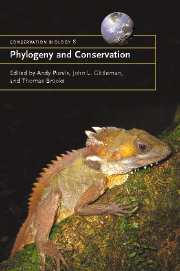Book contents
- Frontmatter
- Contents
- List of contributors
- 1 Phylogeny and conservation
- Part 1 Units and currencies
- Part 2 Inferring evolutionary processes
- Part 3 Effects of human processes
- 12 Conservation status and geographic distribution of avian evolutionary history
- 13 Correlates of extinction risk: phylogeny, biology, threat and scale
- 14 Mechanisms of extinction in birds: phylogeny, ecology and threats
- 15 Primate diversity patterns and their conservation in Amazonia
- 16 Predicting which species will become invasive: what's taxonomy got to do with it?
- Part 4 Prognosis
- Index
- References
13 - Correlates of extinction risk: phylogeny, biology, threat and scale
Published online by Cambridge University Press: 04 December 2009
- Frontmatter
- Contents
- List of contributors
- 1 Phylogeny and conservation
- Part 1 Units and currencies
- Part 2 Inferring evolutionary processes
- Part 3 Effects of human processes
- 12 Conservation status and geographic distribution of avian evolutionary history
- 13 Correlates of extinction risk: phylogeny, biology, threat and scale
- 14 Mechanisms of extinction in birds: phylogeny, ecology and threats
- 15 Primate diversity patterns and their conservation in Amazonia
- 16 Predicting which species will become invasive: what's taxonomy got to do with it?
- Part 4 Prognosis
- Index
- References
Summary
INTRODUCTION
Around one quarter of mammalian species and one eighth of bird species are listed by IUCN as threatened with extinction (Hilton-Taylor 2000); the other species, however, seem not to be at so high a risk. Here, we present a simple scheme for investigating why some but not all species are at risk of extinction. We then assess the strength of phylogenetic signal – the extent to which close relatives are unusually similar – in traits that might predispose species to be at high risk. We find that the signal is so strong that any attempt to explore correlations between biology and risk must consider phylogeny: we outline some ways of doing so, with reference to published studies at a range of scales. We build on previous work in two ways. Firstly, earlier work has tested the correlation of extinction risk with either biological attributes or indices intended to reflect the intensity of threat faced by the species, but not both: we explore the effect of adding threat intensity measures to two previous analyses of biological risk correlates. Secondly, we explore the extent to which the outcomes of tests of hypotheses depend upon the scale of the study – global or local – and try to explain some apparent differences among them. We conclude by drawing attention to the multidimensional nature of threat patterns: correlates of risk can vary among clades, across scales, over time and with the nature of the threat.
- Type
- Chapter
- Information
- Phylogeny and Conservation , pp. 295 - 316Publisher: Cambridge University PressPrint publication year: 2005
References
- 48
- Cited by



